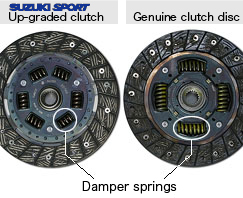Do you think vibration produced by engine oscillation may cause damage to your driveline components over time?. After doing a bit of research, I can see how it could affect driveline components. Prashant Kulkarni, engineering-manager of the Clutch Division at Eaton Corp stated, "All of these engines create different firing pulses in order to operate and it is those pulses that cause oscillations and subsequent vibration." That vibration then moves throughout the entire driveline, “through the clutch, the transmission, down the driveshaft and to the axles.” If vibration gets to be excessive it can break components like synchronizer pins, transmission and U-joint gears, he explains. “It can even [impact] gears down in the axle or any other component that is directly in the torque path of the driveline.”Kulkarni goes onto say, "the damper in the clutch has to be precisely designed, and, in fact, is the most critical part of a clutch."
The stiffness of the clutch damper has an impact on the whole driveline. Kuklarni uses a broomstick and slinky to make his point. If I’m holding a broomstick on one end and someone else is holding it on the other end and I shake my end, the other person will feel every oscillation.” But, with the slinky the other person won't feel the oscillations because the slinky acts like a soft spring.
He quickly adds while a damper isn't as soft as a slinky, "It has to have enough travel designed into it to soften or dampen torsional vibration yet be strong enough to absorb the torque required to power the driveline.”
Keep in mind no one clutch fits all engines. He further explains that you have to find the right cushioning balance. Factors include:
So, it seems to me that the clutch damper is a critical component of clutches and drivelines to prevent damage to the driveline from the natural resonance created by engine oscillation. You need the damper to cushion the effect of the vibrations in order to prevent damage to your driveline componnents (synchronizer pins, transmission and U-Joint gears among some things.
The stiffness of the clutch damper has an impact on the whole driveline. Kuklarni uses a broomstick and slinky to make his point. If I’m holding a broomstick on one end and someone else is holding it on the other end and I shake my end, the other person will feel every oscillation.” But, with the slinky the other person won't feel the oscillations because the slinky acts like a soft spring.
He quickly adds while a damper isn't as soft as a slinky, "It has to have enough travel designed into it to soften or dampen torsional vibration yet be strong enough to absorb the torque required to power the driveline.”
Keep in mind no one clutch fits all engines. He further explains that you have to find the right cushioning balance. Factors include:
- The amount of torque from the engine the driveline needs to support
- The appropriate stiffness/softness of the damper to isolate the vibration energy coming from the engine
- Determining the correct size damper to accommodate the number of springs needed
- The amount of friction material needed to maximize wear life.
So, it seems to me that the clutch damper is a critical component of clutches and drivelines to prevent damage to the driveline from the natural resonance created by engine oscillation. You need the damper to cushion the effect of the vibrations in order to prevent damage to your driveline componnents (synchronizer pins, transmission and U-Joint gears among some things.

Comment